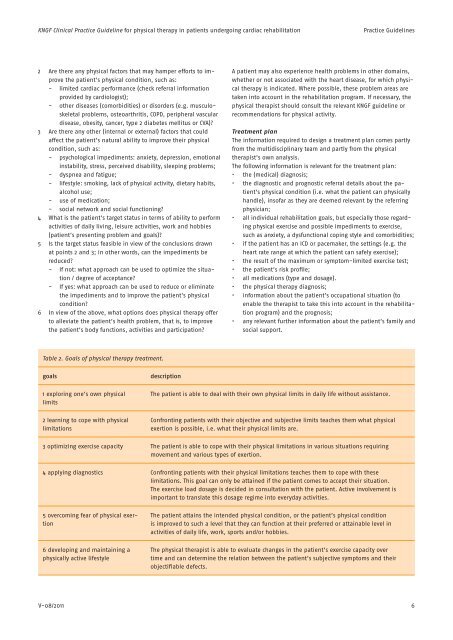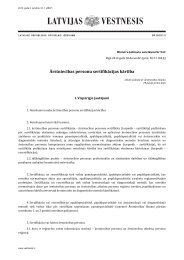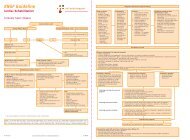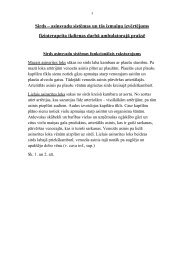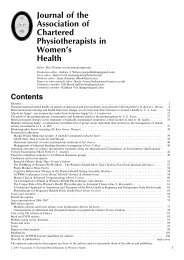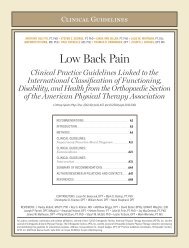KNGF Guideline Cardiac rehabilitation
KNGF Guideline Cardiac rehabilitation
KNGF Guideline Cardiac rehabilitation
You also want an ePaper? Increase the reach of your titles
YUMPU automatically turns print PDFs into web optimized ePapers that Google loves.
<strong>KNGF</strong> Clinical Practice <strong>Guideline</strong> for physical therapy in patients undergoing cardiac <strong>rehabilitation</strong><br />
Practice <strong>Guideline</strong>s<br />
2 Are there any physical factors that may hamper efforts to improve<br />
the patient’s physical condition, such as:<br />
- limited cardiac performance (check referral information<br />
provided by cardiologist);<br />
- other diseases (comorbidities) or disorders (e.g. musculoskeletal<br />
problems, osteoarthritis, COPD, peripheral vascular<br />
disease, obesity, cancer, type 2 diabetes mellitus or CVA)?<br />
3 Are there any other (internal or external) factors that could<br />
affect the patient’s natural ability to improve their physical<br />
condition, such as:<br />
- psychological impediments: anxiety, depression, emotional<br />
instability, stress, perceived disability, sleeping problems;<br />
- dyspnea and fatigue;<br />
- lifestyle: smoking, lack of physical activity, dietary habits,<br />
alcohol use;<br />
- use of medication;<br />
- social network and social functioning?<br />
4 What is the patient’s target status in terms of ability to perform<br />
activities of daily living, leisure activities, work and hobbies<br />
(patient’s presenting problem and goals)?<br />
5 Is the target status feasible in view of the conclusions drawn<br />
at points 2 and 3; in other words, can the impediments be<br />
reduced?<br />
- If not: what approach can be used to optimize the situation<br />
/ degree of acceptance?<br />
- If yes: what approach can be used to reduce or eliminate<br />
the impediments and to improve the patient’s physical<br />
condition?<br />
6 In view of the above, what options does physical therapy offer<br />
to alleviate the patient’s health problem, that is, to improve<br />
the patient’s body functions, activities and participation?<br />
A patient may also experience health problems in other domains,<br />
whether or not associated with the heart disease, for which physical<br />
therapy is indicated. Where possible, these problem areas are<br />
taken into account in the <strong>rehabilitation</strong> program. If necessary, the<br />
physical therapist should consult the relevant <strong>KNGF</strong> guideline or<br />
recommendations for physical activity.<br />
Treatment plan<br />
The information required to design a treatment plan comes partly<br />
from the multidisciplinary team and partly from the physical<br />
therapist’s own analysis.<br />
The following information is relevant for the treatment plan:<br />
• the (medical) diagnosis;<br />
• the diagnostic and prognostic referral details about the patient’s<br />
physical condition (i.e. what the patient can physically<br />
handle), insofar as they are deemed relevant by the referring<br />
physician;<br />
• all individual <strong>rehabilitation</strong> goals, but especially those regarding<br />
physical exercise and possible impediments to exercise,<br />
such as anxiety, a dysfunctional coping style and comorbidities;<br />
• if the patient has an ICD or pacemaker, the settings (e.g. the<br />
heart rate range at which the patient can safely exercise);<br />
• the result of the maximum or symptom-limited exercise test;<br />
• the patient’s risk profile;<br />
• all medications (type and dosage).<br />
• the physical therapy diagnosis;<br />
• information about the patient’s occupational situation (to<br />
enable the therapist to take this into account in the <strong>rehabilitation</strong><br />
program) and the prognosis;<br />
• any relevant further information about the patient’s family and<br />
social support.<br />
Table 2. Goals of physical therapy treatment.<br />
goals<br />
1 exploring one’s own physical<br />
limits<br />
description<br />
The patient is able to deal with their own physical limits in daily life without assistance.<br />
2 learning to cope with physical<br />
limitations<br />
Confronting patients with their objective and subjective limits teaches them what physical<br />
exertion is possible, i.e. what their physical limits are.<br />
3 optimizing exercise capacity The patient is able to cope with their physical limitations in various situations requiring<br />
movement and various types of exertion.<br />
4 applying diagnostics Confronting patients with their physical limitations teaches them to cope with these<br />
limitations. This goal can only be attained if the patient comes to accept their situation.<br />
The exercise load dosage is decided in consultation with the patient. Active involvement is<br />
important to translate this dosage regime into everyday activities.<br />
5 overcoming fear of physical exertion<br />
6 developing and maintaining a<br />
physically active lifestyle<br />
The patient attains the intended physical condition, or the patient’s physical condition<br />
is improved to such a level that they can function at their preferred or attainable level in<br />
activities of daily life, work, sports and/or hobbies.<br />
The physical therapist is able to evaluate changes in the patient’s exercise capacity over<br />
time and can determine the relation between the patient’s subjective symptoms and their<br />
objectifiable defects.<br />
V-08/2011<br />
6


